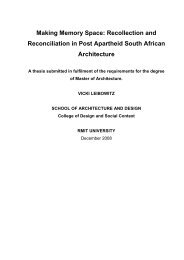Objects in Flux - RMIT Research Repository - RMIT University
Objects in Flux - RMIT Research Repository - RMIT University
Objects in Flux - RMIT Research Repository - RMIT University
Create successful ePaper yourself
Turn your PDF publications into a flip-book with our unique Google optimized e-Paper software.
chameleon-like freezer takes on the spots and stripes of its surround<strong>in</strong>gs.<br />
It is, for <strong>in</strong>stance, a symbol of modernisation <strong>in</strong> the 1970s, a pre-condition<br />
for domestic and economic efficiency <strong>in</strong> the 1980s and a device of<br />
convenience <strong>in</strong> the busy 1990s’ (2000, p. 314).<br />
Stove and Southerton demonstrate how such narratives are <strong>in</strong>fluenced<br />
by chang<strong>in</strong>g social conditions – freezers are established as ‘necessary’<br />
appliances through the normalisation of freezer-dependent foods such<br />
as burgers, pizzas and ice cream (2000, p. 308). They also show how an<br />
object’s functionality imposes certa<strong>in</strong> demands on users, and structures<br />
narratives of use <strong>in</strong> specific ways – freezer use requires an understand<strong>in</strong>g<br />
of the steps needed to prepare food for freez<strong>in</strong>g or defrost<strong>in</strong>g. The<br />
‘becom<strong>in</strong>g normal’ of the domestic freezer is therefore ‘a two way<br />
process <strong>in</strong> which freezers respond to their surround<strong>in</strong>gs and at the same<br />
time impose someth<strong>in</strong>g of their own script’ (2000, pp. 314-315).<br />
Narratives of use position objects with<strong>in</strong> broad social contexts and <strong>in</strong><br />
do<strong>in</strong>g so they ‘make sense’ of an object’s functionality for a specific<br />
social group at a specific time. Such narratives are therefore crucial <strong>in</strong><br />
the formation of mean<strong>in</strong>g structures and the normalisation of objects<br />
with<strong>in</strong> society. It may be argued, as Hackett and Lutzenhiser do <strong>in</strong> their<br />
analysis of the domestic refrigerator, that the consumer’s understand<strong>in</strong>g<br />
of what a particular object is for ‘is a consequence, not a determ<strong>in</strong>ant, of<br />
their use’(1985; cited <strong>in</strong> Shove & Southerton, 2000, p. 315).<br />
Narratives of use are frequently forcefully deployed along with the<br />
objects of mass-production, frequently leav<strong>in</strong>g consumers with little<br />
room to move; ‘gadgets and appliances script the actions of their users<br />
<strong>in</strong> ways which simultaneously create the illusion of choice while also<br />
clos<strong>in</strong>g avenues of possible action’ (Shove & Southerton, 2000, p. 315).<br />
With<strong>in</strong> these imposed regimes of use, the consumer is forced to make<br />
their own mean<strong>in</strong>g with<strong>in</strong> an order they often can not escape. This<br />
‘mak<strong>in</strong>g do’ establishes a degree of plurality with<strong>in</strong> the imposed order –<br />
authorised narratives of use are riddled with the heterogenous stories of<br />
everyday consumer practices. These stories are ‘not simple narrations <strong>in</strong><br />
the standard l<strong>in</strong>guistic sense of the term’ (Law, 2000, p. 2), they do not<br />
simply represent reality but ‘perform themselves <strong>in</strong>to the material world<br />
… <strong>in</strong> the form of social relations, but also <strong>in</strong> the form of mach<strong>in</strong>es,<br />
architectural arrangements, bodies, and all the rest’ (Law, 2000, p. 2).<br />
Reth<strong>in</strong>k<strong>in</strong>g <strong>Objects</strong><br />
33
















